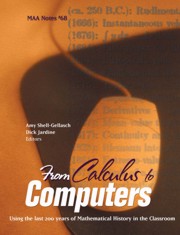Book contents
- Frontmatter
- Preface
- Contents
- Introduction
- I Algebra, Number Theory, Calculus, and Dynamical Systems
- II Geometry
- III Discrete Mathematics, Computer Science, Numerical Methods, Logic, and Statistics
- IV History of Mathematics and Pedagogy
- 16 Incorporating the Mathematical Achievements of Women and Minority Mathematicians into Classrooms
- 17 Mathematical Topics in an Undergraduate History of Science Course
- 18 Building a History of Mathematics Course from a Local Perspective
- 19 Protractors in the Classroom: An Historical Perspective
- 20 The Metric System Enters the American Classroom: 1790–1890
- 21 Some Wrinkles for a History of Mathematics Course
- 22 Teaching History of Mathematics Through Problems
- About the Authors
17 - Mathematical Topics in an Undergraduate History of Science Course
from IV - History of Mathematics and Pedagogy
- Frontmatter
- Preface
- Contents
- Introduction
- I Algebra, Number Theory, Calculus, and Dynamical Systems
- II Geometry
- III Discrete Mathematics, Computer Science, Numerical Methods, Logic, and Statistics
- IV History of Mathematics and Pedagogy
- 16 Incorporating the Mathematical Achievements of Women and Minority Mathematicians into Classrooms
- 17 Mathematical Topics in an Undergraduate History of Science Course
- 18 Building a History of Mathematics Course from a Local Perspective
- 19 Protractors in the Classroom: An Historical Perspective
- 20 The Metric System Enters the American Classroom: 1790–1890
- 21 Some Wrinkles for a History of Mathematics Course
- 22 Teaching History of Mathematics Through Problems
- About the Authors
Summary
Introduction
An undergraduate survey course in the history of science presents numerous opportunities to discuss the role of mathematics in scientific developments, especially with regard to physics and astronomy. These courses are most commonly taught in a history department, or a history of science department. Although there may be some modest prerequisites in terms of science and mathematics, these are history courses, not mathematics courses, and it is usually inappropriate to treat mathematics topics in rigorous detail, and especially inappropriate to evaluate student solutions of mathematics problems as part of the course grade. But no such course can be considered complete without some reference to mathematics. Some description of the possibilities for treating mathematics within a history of science course may be beneficial for teachers of more mathematically oriented history courses, who may derive some ideas for incorporating history of science into their mathematics presentations.
Restricting attention to the last 200 years leaves no shortage of topics, but increases the difficulty of providing accurate but comprehensible explications of the mathematical issues. Historians of science may approach topics from a more philosophical standpoint, or indulge in more hand-waving, than some teachers of mathematics would find agreeable. Mathematicians may find that a history of science survey course is too much of a romp through the decades and centuries, flitting from one topic to the next without ever getting to the details. The following are examples of treatments of mathematical topics in the history of science classroom, assuming students have a basic understanding of algebra and geometry.
- Type
- Chapter
- Information
- From Calculus to ComputersUsing the Last 200 Years of Mathematics History in the Classroom, pp. 201 - 206Publisher: Mathematical Association of AmericaPrint publication year: 2005

